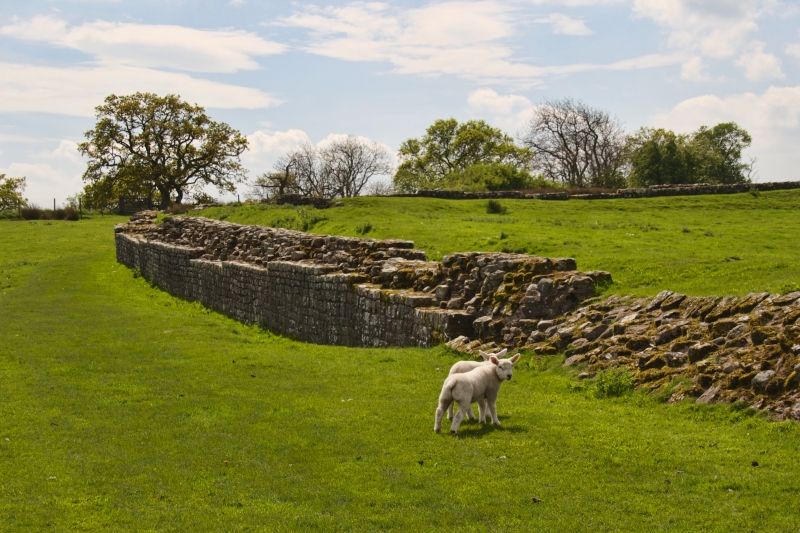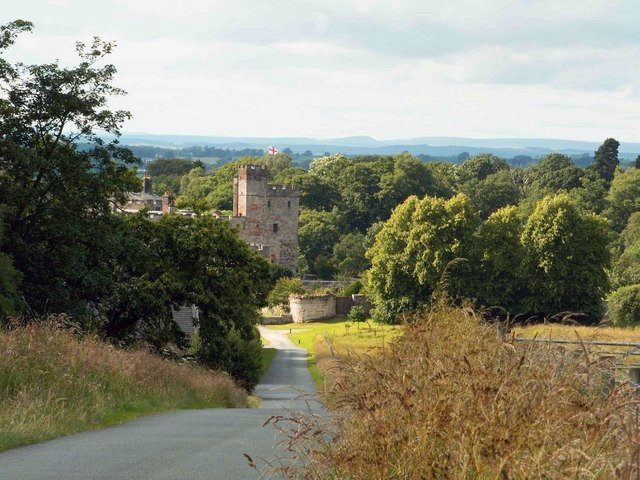
There are lots of rabbits on this road, fat brown bunnies nibbling at tall grasses that grow beneath high hedgerows. It is past noon now and Sunday morning's respite over, a farmer appears on a side road. Two border collies run across the road to greet him. One has apparently made this mad dash unsuccessfully at some time in the past, as he only has three legs.
Naworth Castle appears from around a bend in the road, a flag fluttering atop the Norman tower. Former home of the Dacres, this castle is privately owned and presently occupied by the Howards of Castle Howard. It is not open for viewing, but that's okay; we already know how the other half lives.
From Naworth it's just a quick jaunt on a clear road to the A69, (or was that the B6318?) which parallels the Roman wall. The wall ranges up and down the rolling hills with the vallum spread before it like a length of rippling green velvet. After years of reading books and poring over pictures of Hadrian's Wall, I feel as if I am dreaming. I stare silently out of the window as we drive along beside it.
We pull into a little car park at the bottom of the hill that leads up to the remains of Birdoswald. But we're not here to visit Birdoswald, we're here in search of the infamous Roman graffiti.
Now, some people will look at the phallic symbol that is carved on the wall here and think of it as pornography, but the phallus was viewed as a sign of good luck and prosperity, along with fertility. I doubt that whoever carved this symbol into the stones was snickering over it, just as I am certain that hundreds in our century have.
The wall is broken down in places here and it's an easy climb to walk along the top. I'm walking on top of Hadrian's Wall! I feel like a child at Christmas – dizzy with excitement, dizzy with a sense of triumph, dizzy with ... another attack of vertigo. How can this be? I'm only ten feet off of the ground. I climb back down, disappointed in myself for this weakness.
Walking alongside the wall toward Willowford we look out over a steep drop to the River Irthing. Here I climb up on the wall again for a panoramic view of the area, only to see the world spin. I had been thinking about my attacks of vertigo and suspected that it may have something to do with the glasses I had purchased only a few months before departing on this trip. I decide at this point to experiment a bit, and take my glasses off.
The view is a little blurry, but at least it stops spinning. I've found the culprit responsible for my attacks of vertigo. For the remainder of the trip I remove my glasses whenever I look down at something.
Fielding cow and sheep pats covered with swarms of yellow dung flies we traipse back along the wall. The terrain here is rough and greatly populated with sheep but it's a pleasant walk back to the gate at Birdoswald, where we stand on the bottom rung of the fence surrounding it to see what we can see, which is basically – nothing besides the visitors' center. We plan to visit Vindolanda later though, and much more to see this day, so we pass up a poke around the ruins here.

Naworth Castle, also known as, or recorded in historical documents as "Naward", is a castle in Cumbria, England, near the town of Brampton. It is on the opposite side of the River Irthing to, and just within sight of, Lanercost Priory. It was the seat of the Barons Dacre.
Thomas Dacre (1467–1525), who commanded the reserve of the English army at the Battle of Flodden and was known as "the Builder Dacre", built the castle's gateway and placed over it his coat of arms with the Dacre family motto below: Fort en Loialte (Norman-French: "Strong in Loyalty").
Lord William Howard, Dacre's successor, purchased back the Dacre family estate from King James and took up residence with his children and grandchildren at Naworth Castle. He restored the castle, improved the estate and established order in that part of the country.
Sir Walter Scott described the castle as: "one of those extensive baronial seats which marked the splendour of our ancient nobles, before they exchanged the hospitable magnificence of a life spent among a numerous tenantry, for the uncertain honours of court attendance, and the equivocal rewards of ministerial favour."
Read more about Naworth Castle at Wikipedia.